Iconography
Such an appraised good as the Court of Waters is in the history of our city and kingdom, such a model institution that has survived the passing of centuries, in the same way that has been reflected in writings of travellers, literate, authors writing about local customs, chroniclers or simple visitors throughout all times, its graphical image, as well as the one of the Turia river, has served to illustrate different works of investigation on the same. Simple reviews of trips, novels, or iconography of covers, fountains and monuments in which the noble figures of the receivers and men of the fertile region of Valencia, sitting in that primitive bench or the strong armchairs of our days, dressing their colourful suits or austere traditional black smocks, represented the Valencian, our customs, our history, the roots of a town that go beyond the past millenium and that has always reminded us of the many aspects of our personality and identification as a town. That is why esteem, affection, pride and admiration are awaken in their sessions every Thursday; they are not great crowds, but the Court is always wrapped in its short and effective session of work by those who approach every time with greater frequency the iron gate that protects its enclosure.
Iconography of The Water Court and Acequias de la Vega
Tomás Rocafort
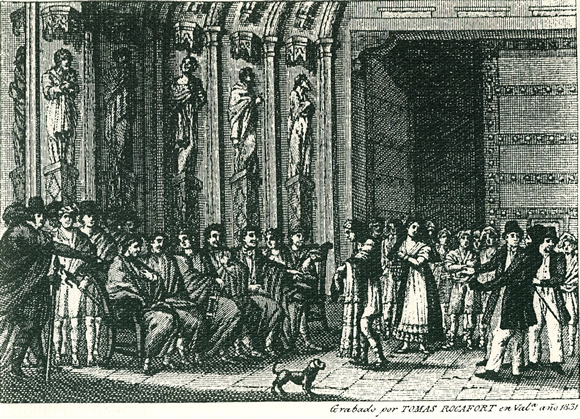
The work Tratado de distribución de las aguas del Río Turia y del Tribunal de los Acequieros de la Huerta de Valencia, by the Valencian jurisconsulto Francisco Javier Borrull and Vilanova, published in Valencia, in 1831 and which came from Benito Monfort´s printer´s, illustrates this engraving. The engraving appears in the head of the titled chapter Del Tribunal de las Acequias, de los deslindes que lo componen, su jurisdicción, modo de proceder no menos breve que importante para mantener en buen estado la agricultura, y Príncipe que lo estableció.
This engraving, with hardly modification, served as model to the painter Bernardo Ferrandis for its well-known picture the Court of Waters in Valencia, which is in the Museum of Beautiful Arts of Bordeaux, and from which there is a well-known retort in the Provincial Delegation of Valencia.
Gustavo Doré
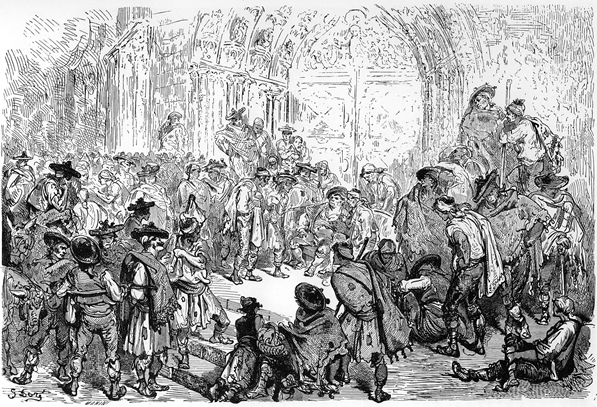
This well-known illustration of the equally famous illustrator Gustave Dore, appears in the magazine Le Tour du Monde. Nouveau journal des voyages, published under the direction of Éduard Charton and, in this case, illustrated texts Tour Davilliers Baron, who speaks of the origin of the Water Court, the fertility of the land of Valencia and the importance of risks, recounting his experience:
“we didn´t want to miss the meeting, and before twelve we were mixed with the multitude of farmers in the first row. The judges, representing the “drains” of the fertile region of Valencia, occupied their position and were sitting on a simple velvet upholstered coach of Utrecht, belonging to the chapter of the cathedral, which is forced to provide the seats… are all the furniture of the court: a table would be useless because the use of paper, pens and ink is useless for these authentically Biblical judges who reminded us of king San Luis talking about justice under the oak of the forest of Vincennes”.
Doré captures in his images the richness and colourful noise of a scene that is repeated every Thursday in front of the door of the Apostles of the cathedral of Valencia: men of the local farming region, simple pedestrians, curious people… who, now and then, shield the Court in their deliberations and sentences.
José Benlliure
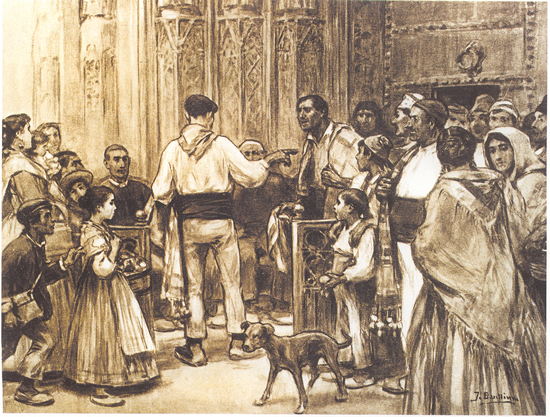
This illustration appears among those which the painter Jose Benlliure prepared for the luxurious edition of the work La Barraca by Vicente Blasco Ibáñez that the Editorial Prometeo made. Once again, the popular characters, men of the fertile region of Valencia, pedestrians, the street dog, that also appeared in the engraving of Tomás Rocafort, surround the denounced receivers of the legendary Court located within their iron gate in the door of the Apostles. The similarities with the engraving of Rocafort, as well as with the picture of Ferrándiz, are evident.
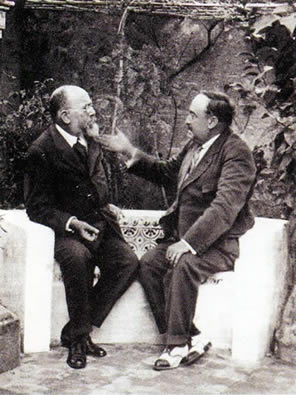
Jose Benlliure was the season director of the Museum of Beautiful Arts of Valencia, appointment that was received in 1924 and which meant a great responsibility during the last years of his life. Nevertheless, he was faithful to the easel painting developing his own artistic work, which he never left. At that time he faced an artistic activity that he had never boarded: the written work illustration. After his first work, which consisted on putting images to the Life of San Francisco de Asís, written by the Father Torró, he received the order of his friend Vicente Blasco Ibáñez.
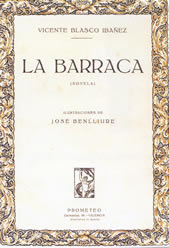
In the triumphal return to Valencia of the novelist, on 15th May 1921 and the received tributes from the City, Blasco Ibañez visits his friend Don Jose Benlliure in his house in Blanquerías street, to change impressions on the illustrations that he is doing for a special edition of his novel, which had become the most popular of his works. His interest on the fact that Benlliure illustrated his work was so big that he was ready, according to what he had commented, to transfer the royalties of that edition in favour of Don Jose, if it was necessary to convince him. It was not either the first time that this novel was illustrated, because in 1903, the painter Antonio Fillol did it with 80 illustrations, but the edition did not have great success, in spite of the worth of the illustrator. In 1932, with the inauguration of the Palacio del Retiro of Madrid of the Manifestaciones de Arte Valenciano, the 52 works presented by Jose Benlliure for the edition of La Barraca drew the attention. Nevertheless, the project was delayed, perhaps because of the fact that Blasco had started his trip around the world, or because he had activities in the field of cinema; the certain thing is that the writer died on 28th January 1928 and his son-in-law, Fernando Llorca, manager of the then Editorial Prometeo, thought about the convenience of publishing the old project of La Barraca as a posthumous tribute. It came out on sale on 2nd December, with 36 illustrations of the 52 initial ones, being printed in the factories of the Editorial Prometeo, in the Gran Vía Germanías, 33, of Valencia.
Bernardo Ferrándiz
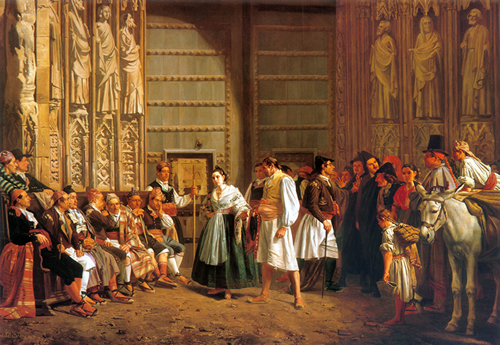
It is, doubtless, the most universal image of the Court of Waters. Bernardo Ferrándiz, one of the initiators of the thematic local customs Valencian painting, began in 1860 in Paris an artistic career that made him the most famous Spanish painter on active service before the arrival of Fortuny. After having obtained the second medal in the National Exhibition of 1862, celebrated in Madrid, with his work Las Primicias, being granted a scholarship by the Delegation of Valencia that allowed him to extend his formation abroad, proposed to paint the Court of Waters in Valencia, that would be directed by the professor of the French Academy Ms. Duret during his staying in Paris and while his pension lasted. Therefore, the work began in 1863 in Paris being completed during a staying of several months in Valencia to take notes from the natural one. Nevertheless, in the course of a year, the picture will see its title modified by the one of the Court of Waters in Valencia in 1800, and so the picture, besides being “costumbrista” (local customs painting) happens to be a history picture; the reasons are to be found in the desire of the author of displaying his work in the Universal Exhibition of Beautiful Arts of Paris of 1864, then, following the advice of professor Duret, who considered that the works of historical subject had more possibilities in this type of exhibitions. The author did not obtain the medal that he expected, nevertheless, in compensation, the director of the Administration of the French Beautiful Arts, addressed the author in order to purchase the picture by the Minister of the House of the Emperor and the Beautiful Arts, valuing it in 6.000 francs; reason why it is one of the paintings in the collection of the Museum of Beautiful Arts of Bordeaux, being, according to C. Reynero («Los pintores valencianos del siglo XIX entre Roma y París», en Maestros de la pintura valenciana en el Museo del Prado. Madrid-Valencia, 1997) the first occasion in which a work of a painter born in the south of the Pyreneans was acquired by the French to be exposed in a museum.
As the work was acquired by the government of Napoleón III, in 1865, Ferrándiz felt obliged to paint a retort of the same to give it to the Delegation of Valencia that had paid for his studies; the local press echoed it (La Opinion, 3rd September 1865, indicated: “Mr. Ferrándiz is finishing a remarkable repetition of the picture the Court of Waters, work destined to decorate one of the fronts of the new hall meetings of the provincial Delegation”).
The Court of Waters is an essential work for its emblematic character, because it reflects a present reality strongly deeply rooted in the Valencian history and at the time at which it was painted it was like a symbol of the lost autonomous liberties. The meticulousness of details of the work, the clothing, constitutes a rich source of information on the life of the Valencians of the 19th century that B. Ferrándiz knew well; even among the characters, some of them are close to the painter; his father incarnates the president of the Court and some of his professors of the Academy of San Carlos are portrayed as receivers of the same. Recently in 2004, the Acequia de Robella has been able to state, that the receiver who appears sitting thirdly (beginning to count on the left) in the picture, is Mr Salvador Aleixandre Tarrasa, who was the receiver of this Acequia at that time, which makes the previous opinion spilled in the ample study realised by C. Gracia (El Tribunal de las Aguas. Ferrándiz ante la Modernidad. Valencia, 1986), doubtful.
Ernesto Furió y Arturo Ballester

Furthermore,in our days, different artists, engravers, painters… have represented the survival of all the Valencian in their works in their daily task, of everything that is found in each corner of the city, of the little fertile region that surrounds it, which reminds us of our identity and stays as memory of the same in illustrations of books and publications of all type. The illustrations that, property of D. Vicente Giner Boira, were included in the first edition of his work the Court of waters are an example. They were done by Ernesto Furió and Arturo Ballester, artists so deeply Valencian as was the author.
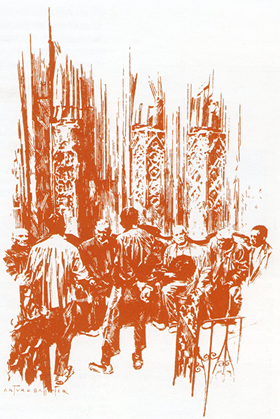
The first, university professor of engraving in the School of Beautiful Arts of Valencia, master painter of so many generations, national prize of engraving 1947 and gold medal of the Society of Recorders, prolific watercolorist in the last years of his life, contributed with one of them in the work of Giner Boira because of their friendship. The second, Arturo Ballester, contributed with a beautiful reproduction of the Court with affectionate dedication to the one that gave so many years of his long life to this institution, as well as to all the Valencian: “Al amante de las Bellas Artes, don Vicente Giner Boira, amistoso recuerdo. Arturo Ballester” “To the lover of the Beautiful Arts, Vicente Giner Boira, in friendly memory. Arturo Ballester”.
El Gancho (The Hook)
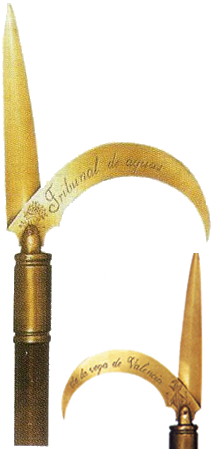
The “gancho” (hook), is the emblem of the millenarian Court of Waters and a faithful witness, together with the apostles of the gothic door of the Cathedral of Valencia, of its deliberations throughout the centuries. Thus was seen by Gustavo Doré, Tomás Rocafort, Jose Benlliure, Ferrándiz ,… and those who left testimony of this dear Institution, pride of all the Valencians, model of legal institution of world-wide recognition in their graphical work.
 |
|
| Paco Roca Ortí, Sheriff Court during the past quarter century. |
E
This rudimentary and ancestral instrument, always present in the life of the agricultural towns of the Mediterranean, was very useful in its daily task. Despite its offensive appearance, its inappropriate harpoon form that presumes attack or defense, its aims could not be more pacific since, to solve problems and to dissolve litigations, there was the Court which, even-tempered and unquestionable, deliberated and sentenced every Thursday, at twelve o'clock, in the Door of the Apostles of the Cathedral of Valencia, scene of its activities.
The hook was, and is, the instrument of daily work of the guards of the drain. Its fundamental utility is the one to raise the floodgates of the partidores so that the water runs along the drain in search of the fields that is going to water; in addition, it is the most effective instrument to undo and to release the obstacles of the drains. Its end, as an unexpected harpoon, helps the guard to capture the table that is escaped.
The “alguacil” (bailiff), is the carrier in the official acts and burden and solemn, dressing his traditional black smock, in the deliberations of the Court of Waters every Thursday, initiates the sessions calling from the door of the iron gate: “¡Denunciats de la séquia de Quart!”(“Denunciats of the drought of Quart!”.)
El Turia y sus Acequias
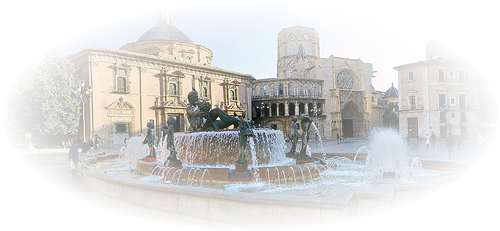
The origin of this fountain of the Plaza de la Virgen of our city dates from the past forties. Indeed, in January 1944, on grandstands, the cup of a fountain that would be dedicated to the Liñán canon was settled for his outstanding prominence in bringing potable waters to the city. Nevertheless, the works were paralyzed until the last reform of the Plaza de la Virgen was carried out. Later, the project was replaced by another which located a bigger fountain next to the street of Navellos, leaving a more diaphanous space for the great celebrations that habitually take place in this square. In this fountain, the Turia river is personified in a lying giant, carrying the horn of abundance, or of Amaltea, as a symbol of the wealth that its waters mean for the fertile valley of Valencia. There are eight feminine figures of naked adolescents on pedestals around him, carrying individual water pitchers that spill in the cup of the fountain and they remind us of the eight drains of the fertile valley. The figure of the Turia father has classic evocations and reminds of the figures of the antiquity that personify the Nile, the Tíber or the beautiful baroque fountain of Bernini dedicated to the Four Rivers, which is in the center of the Roman Navona square. The figures were work of Silvestre de Edeta (Manuel Silvestre Montesinos). The fountain was inaugurated in 1976.


